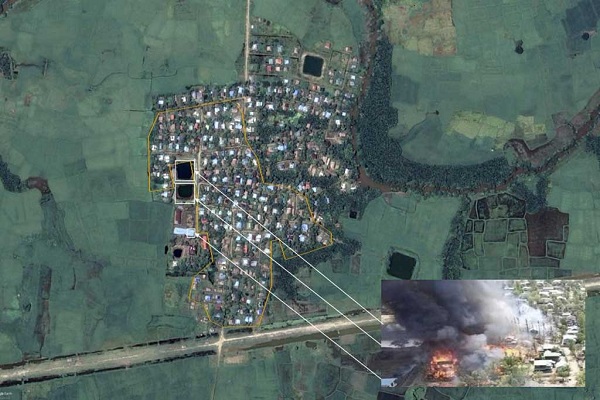Homes Burned Down in Muslim-Majaority Rakhine State of Myanmar


In a statement on their website on Tuesday, HRW said satellite imagery showed that about 200 homes and other buildings were destroyed by fire on May 16, 2020, in the predominantly ethnic Rakhine village of Let Kar in the Mrauk-U township of Myanmar’s embattled Rakhine State.
“Since January 2019, fighting between the Myanmar military and the ethnic Rakhine Arakan Army has resulted in numerous civilian casualties and destruction of civilian property. The imagery of Let Kar bears a close resemblance to patterns of fires and widespread arson attacks by the Myanmar military on ethnic Rohingya villages in Rakhine State in 2012, 2016, and 2017,” the statement said.
“A credible and impartial investigation is urgently needed to find out what happened, punish those responsible, and provide compensation to villagers harmed,” HRW Deputy Asia director Phil Robertson said.
The rights group also said satellite imagery recorded on May 16, 2020, at 10:30am showed no signs of damage in Let Kar. But at 2:12 pm, an environmental satellite detected extensive fires burning at the village.
It also said the damage analysis of 200 buildings being burned was most likely an underestimate as internal damage to buildings were not visible, it added.
“Myanmar’s government should not leave the investigation of this incident to the military, which has repeatedly covered up atrocities and exonerated its troops,” Robertson said.
“To ensure a credible investigation, the government should request UN assistance.”
“The satellite imagery is consistent with witness accounts regarding the date and time of the fires and the number of buildings affected. Residents in the neighbouring village of Bu Ywat Ma Nyo told the media they saw Myanmar soldiers walk past their village to enter Let Kar around 2 pm on May 16 and leave around 5pm,” the statement said.
“The two villages are nearly one kilometre apart. After the soldiers entered Let Kar, Bu Ywat Ma Nyo residents reported hearing gunfire, saw flames and smoke, and observed two aerial drones, one flying above Let Kar and another flying over Bu Ywat Ma Nyo village.”
The rights group also quoted an aid worker from the town of Mrauk-U that at 2pm on May 16, columns of smoke could be seen coming from the direction of Let Kar, 11 kilometers north.
“There was no one living there after the fighting last year as [the residents] had fled, but the older people really have nowhere to go now,” he said.
“They had been sheltering in IDP [internally displaced persons] camps in Tein Myo and Bu Ywat Ma Nyo villages and had at least been able to go home and collect their belongings or check their homes from time to time. Now they don’t have anything – it’s very sad,” the aid worker told the rights group.
A Rakhine State regional member of parliament, Tun Thar Sein, confirmed HRW that a military contingent had been in the area.
“We will urge the union government for compensation and aid to be provided to the residents of Let Kar,” he said.
On May 17, Myanmar’s military released a statement that its troops had entered Let Kar the previous afternoon while patrolling the area and were attacked by the Arakan Army. It also issued an aerial view image of burning buildings in Let Kar, presumably taken by a drone.
The military accused the Arakan Army of setting the fires and damaging at least 20 houses before retreating into the mountains.
On May 19, the Arakan Army issued a statement denying the allegations, where their spokesperson, Khine Thuka, urged the media to investigate.
Since August 25, 2017, Bangladesh has been hosting over 1.1 million Rohingyas following a military crackdown on the predominantly Muslim minority state Rakhine.
Source: The Dhaka Tribune



